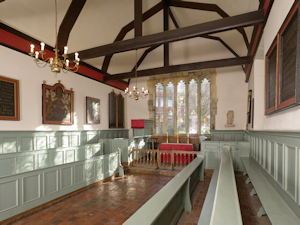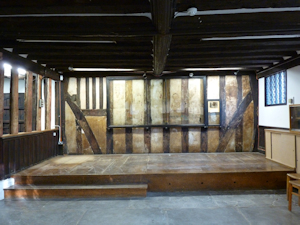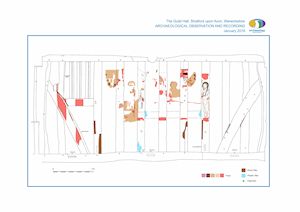

Many 15th-century guildhalls such as Trinity Hall, York, and St Mary's, Boston, contained small chapels for the use of guild members, their chaplains and almsfolk, in addition to their more elaborate chapels located in nearby churches (Figure 16) (Giles 2000; Giles and Clark 2011). At Stratford-upon-Avon a small guild chapel appears to have been created at the southern end of the lower guildhall, adjacent to the parlours of the guild chaplains and alongside their much more impressive and formal Guild Chapel (Figure 17). Archaeological recording undertaken by the University of York and Archaeology Warwickshire (2016) has revealed a series of peg holes and empty mortises, suggesting the presence of a low platform or dais against the southern wall that was replicated by a 19th-century raised floor in this area, removed during development works (Figure 18). An altar, probably made of wood but possibly of stone, would have been positioned in the centre of this platform, lit from the east by a small window that was probably blocked only two years later, in 1427/8, when the schoolroom and chamber over it were created in the building now known as the 'infill house' (Arnold and Howard 2010; see Shakespeare Centre Library and Archive (SCLA) BRT/1/3/38 for records of the construction of the schoolhouse).

In 1425/6 the Stratford-upon-Avon guild accounts refer to payments made to Sir Thomas Burdet, knight 'pro Ratificatione' of the Chapel, in the Hall of the said Guild newly-built (SCLA BRT 1/3/35). Sir Thomas Burdet of Arrow, Warwickshire (d. 1442), and his wife Isabel, were regionally-prominent members of the gentry, closely connected with the Beauchamp affinity and members of the guild of Holy Trinity, Coventry, as well as the Holy Cross guild in Stratford-upon-Avon (Woodger 1993). Burdet was a colourful character with a violent temper. Notwithstanding his role as an MP, he and his servants were accused of assaults, violent brawls and even manslaughter in the latter years of the 14th and early 15th centuries. By 1427 he appears to have been living a quieter life. Burdet features regularly in the Holy Cross guild's Masters and Proctors accounts as a signatory for deeds and leases. His signature and an armorial seal of red wax are attached to the grant of land to John Harys the `scolemayster' on 27 March 1424 (SCLA BRT/1/2/427). The surviving accounts regularly record payment for 'hoods' sent to Burdet and his family from 1408/9 (see references for these in SCLA BRT/1/3/13), between 1411-17 (SCLA BRT/1/3/26), in 1421/1 (SCLA BRT/1/3/33), 1424/5 (SCLA BRT/1/3/35) and 1427/8 (SCLA BRT/1/3/38). Burdet and his wife were provided with breakfast in the hall by the Council in 1421/2 (see records of these payments in SCLA BRT/1/3/33), and in the chapel in 1431/2 (this payment is recorded in SCLA BRT/1/3/42).

Throughout his career, Burdet was closely connected with Thomas, Earl of Warwick. His role within the Beauchamp affinity may well have encouraged him to include the Beauchamp coat of arms and heraldry in the decoration of the Guildhall chapel. Burdet appears to have played a major role in the consecration of the small chapel within the Guildhall in 1425. The Masters and Proctors' accounts for 1424/5 record his expenses in the formal ratification of the Guildhall chapel. Although the accounts suggest that it was the Proctors of the guild who actually travelled to Rome to secure its consecration licence, Burdet may have overseen the project, including the minor alterations ('pro reformatione') of the new Hall 'as far as the chamber of John Mortemer'. These alterations must have included the insertion of the window in the east wall and the installation of the altar platform, and associated fixtures and fittings. The accounts record 12d spent on altar linen ('pro panno blod' lineo') and on rings and 'le wyre' for the same, with a further 5d spent 'hemyng'. Artificial light from a 'torch' was also provided. The consecration of the chapel appears to have been a convivial affair, enhanced by music for which the guild recorded a payment of 20d to "le Mynestreles de Warrwick" (see the guild accounts SCLA BRT/1/3/35). Burdet's involvement in the project may reflect his patronal aspirations; the desire to be recognised in life and remembered after death by the guild and its chaplains. It seems likely that Burdet would have been involved in the design of the painted decoration of the Guildhall chapel. It is to the evidence of this scheme that this article now turns.
Internet Archaeology is an open access journal based in the Department of Archaeology, University of York. Except where otherwise noted, content from this work may be used under the terms of the Creative Commons Attribution 3.0 (CC BY) Unported licence, which permits unrestricted use, distribution, and reproduction in any medium, provided that attribution to the author(s), the title of the work, the Internet Archaeology journal and the relevant URL/DOI are given.
Terms and Conditions | Legal Statements | Privacy Policy | Cookies Policy | Citing Internet Archaeology
Internet Archaeology content is preserved for the long term with the Archaeology Data Service. Help sustain and support open access publication by donating to our Open Access Archaeology Fund.